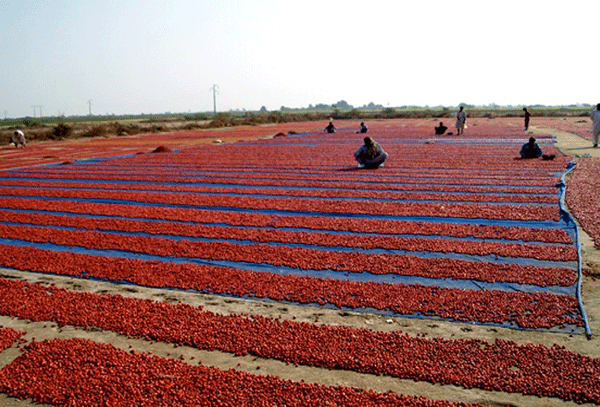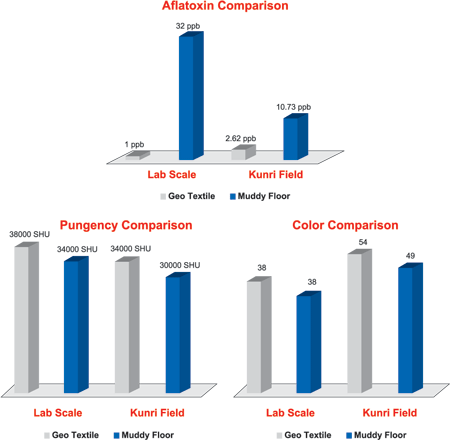Introduction
Red chilies are widely used in South-Asian cuisine since last many decades. Unfortunately red chillies in Pakistan undergo Aflatoxin contamination, which can occur in the fields during the process of harvesting, post-harvesting, drying and storage. Aflatoxin is produced by fungi growing on the chili plant and fruit, and is carcinogenic. At least 13 different types of Aflatoxins exist where Aflatoxin B1 is considered the most toxic. Pakistani chili powder is failing international tests due to high levels of Aflatoxin, resulting in loss in export potential. This study addresses the Aflatoxin issue pertaining to red chilies in Pakistan, highlights the effort of National Foods Limited to address this problem, the importance of Chilies as a commercial product and results of research work done in Kunri field. It is expected that this study will help in alleviating this problem and give readers a clear idea of feasible solutions.
World market for chilies
India is the largest producer of chilies in the world contributing 25 percent of the total world production, of which only 4 percent is exported because of high domestic consumption. Besides India, other major producers and exporters are China, Pakistan, Morocco, Mexico and Turkey. Major importers of chilies from Pakistan are Gulf States, the US, Canada, Sri Lanka, the UK, Singapore and Germany. It is exported in different forms that are: fresh chilies, stalk less chilies, chili powder and oleoresin, as another form.
Export of red dried chilies from Pakistan has declined from Rs1.127 billion (during 2003-2004) to Rs846 million after European Union food authorities have detected the presence of aflatoxin (Pakistan Horticulture Development and Export Board (PHDEB). Its production fulfils 88 percent of the country?s requirement. Chili not only meets domestic consumption but also helps in earning foreign exchange. The potential for increasing exports of whole, powder and crushed chilies in consumer packs is very high, provided we meet the stringent quality requirements of importing countries by preventing contamination from external sources during harvesting, post-harvest handling, processing and storage.
China, India, Spain and Peru are the largest producers and exporters of chilies with the export market share of 27%, 16%, 11% and 9% respectively in the world. The value of total import for this product in the world is estimated to be US$ 602,343,000.
The Aflatoxin issue
Aflatoxin belongs to a group of fungal toxins known as myco-toxins. It was discovered some 30 years ago in England following a poisoning outbreak causing 100,000 turkey deaths. Mycotoxins have received considerable attention due to their significance in agricultural loss and human health. Amongst the mycotoxins that are known to cause human diseases, aflatoxins have been studied the most.
Aflatoxin poses a potential threat to food safety. As aflatoxin is epidemiologically implicated as carcinogen in humans and an environmental contaminant which is widespread in nature, it?s possible chronic toxicity is of greater concern than acute toxicity.
Aflatoxin maximum allowable limit
Aflatoxin maximum allowable limit (in Parts Per Billion ? PPB) in regulation of various countries is given below:
- USA 20
- CANADA 15
- EU 05
- BRAZIL 30
- AUSTRALIA 15
- JAPAN 10
- CHINA 10
- INDIA 30
- IRAN 10
- MALAYSIA 35
In Pa1kistan, the Aflatoxin level in chilli crop varies from 02 PPB to 100 PPB. With this level of Aflatoxin; we cannot compete in the international market. A lot of work is required to improve the quality of chilli crop.
Role of National Foods Limited
NFL is Pakistan’s largest single purchaser of raw-red chilies, an essential ingredient for many of its products. As part of its Sustainability Strategy, NFL has undertaken a planned effort, starting at the grassroots level, to support quality improvement and enhanced production of red chili in Pakistan. The initial stages of this effort include knowledge sharing and trust building activities. National Foods played host to a large group of chili stakeholders in Sept 2008 – including chili growers, research specialists and concerned NGOs.
NFL has pioneered post-harvest techniques to reduce Aflatoxin levels in red chilies. The company developed a Value Chain Empowerment business model for red chili detoxification and modified drying. The objective of this business model is improvement in the quality of red chili and in production and expansion of Aflatoxin-free chili in the country. As part of its sustain-ability strategy, linkages were identified and developed, between the company’s growth and stakeholder engagement, with the objective of bringing sustainable economic benefits to the wider community. NFL has gone through a lot of effort to understand and solve the Aflatoxin problem. One of the techniques, using geo-textiles, proved to be a success.
Geo-Textile Pilot Project
Objective:
To eliminate or reduce Aflatoxin to minimum levels without compromising other quality parameters like color and pungency. The project was run on Lab scale for a three months period and validated in field (with collaboration from a large Kunri farmer) during the two month harvesting period.
Fresh chili was spread on geo-textile on muddy floor while parallel fresh chili was spread on muddy floor as conventional practice is conducted in Kunri fields. Validation part was conducted over a 150 square yard area (with and without geo-textile blue cloth as seen in the photo on page 18)
Commercial Scale:
Then the geo-textile experiment was run on commercial scale for approximate 80 MT, shipment was sent to England in January 2010.
Results
- Internal Test Report of National Foods Lab showed the chili powder sample to be within EU limits for Aflatoxin & microbial contamination.
- Report from PCSIR (Government accredited Lab) showed the chili powder sample to be within EU limits for Aflatoxin and Pesticide Residue.
- Report from CAMPDEN BRI EU lab Research showed the chili powder sample to be within EU limits for Aflatoxin.
First export of test product:
A chilli powder shipment of 20 tons was sent to England in January 2010. Test results from receiving port came at the end of February 2010. The shipment passed the required Aflatoxin levels! To conclude, the techniques successfully pioneered by NFL need to be reapplied on a wide scale with the help of the local farming community. Additionally, Pakistani Food Laws should bring the allowed Aflatoxin levels at par with inter-national standards, including India and the EU.








Dear Hussain You have done a good job,
I also live in kunri and I have researched on this issue and i have introduce a new technique for dryer mechenisim and i remove aflotoxin and fungi from red chili.
Thanks
Qurban bhatti
Fellow IDSP
Dear Mr.Muneer,
Good and informative artical,its help for my buisness.
Once again thaks Mr,Muneer.
Nasir Shahzad
CEO
AR Group.
Hello,
I wish good luck to Hussain for this research we must do more care for every body’s
Health.Because as nation we are way behind from other civil nations.
I found this weblog quite interesting. The facts and exact suggestions are exactly what I was looking for. I’ve book marked and will be back again.
Useful article. I’ll be bookmarking your site so i can accrue up from the future. wants to discover added posts soon.
As I site possessor I believe the content material here is rattling excellent , appreciate it for your efforts. You should keep it up forever! Best of luck.
In some conditions its an ache to assess what online website proprietors authored, but this website is honestly consumer genial !!
I am linking this web page from my personal web page .
Heya i’m for the first time here. I found this board and I found It really useful. it helped me out a lot. I’m hoping to present one thing again and aid others like you helped me.
very cool website!! Man .. Excellent .. Superb .. I will bookmark your site and take the feeds additionally. I’m glad to find so many helpful info right here in the put up, we’d like work out more strategies on this regard, thank you for sharing. . . . . .
Nearly all of whatever you point out is supprisingly legitimate and it makes me ponder the reason why I had not looked at this in this light before. This piece truly did switch the light on for me personally as far as this subject goes. Nonetheless there is actually one particular factor I am not necessarily too comfortable with so whilst I attempt to reconcile that with the actual main idea of the point, permit me observe just what all the rest of the subscribers have to say.Very well done.
I finally found out how to create a comment on your weblog. I just desired to say that I truly take pleasure in reading your posts.
I agree 100%
Wow sir, MASHALLAH you have done great work. May Allah give you more strength and knowledge. Its wonderful and really informative. keep it up
good effort mind sharing the details of the geo textile used???
It’s great to see this work posted here.
This work was done in collaboration with Textile Research an Innovation Centre (TRIC), established at the Textile Institute of Pakistan (TIP). Our team had the fabric analyzed and worked on sampling and development of the blue fabric that was eventually used for field testing.
It is great that that National Foods is conscious about welfare of people living in rural areas.
Very good and informative article, may you write more items like these in the future. God Bless you and your family.
Very interesting and informative article, it shows National Food is having most professional and qualified people working with them, who are providing quality product to their cusumers.
Dear Mr. Muneer,
Assalam U alikum! Sir you have done a tremendous job mashallah. As i have seen you live in your laboratory doing your great efforts for achieving the results of Aflatoxin in Red Chilli within the utilization all yours limited resources available in your lab is a great achievement to proven your skill and devotion in the field of Food safety.
Congradulation’s from myself and the whole team of M/s. Technology Links (Pvt) Ltd.
May Allah give you more success in life ameen.
Regards,
Nauman
(Asst. Manager Sales)
M/s. Technology Links (Pvt) Ltd.